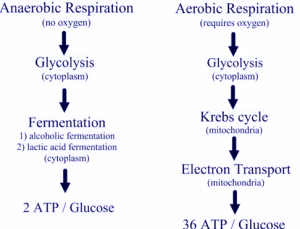Aerobic and anaerobic respiration are carried out at the cellular level. Cellular respiration refers to a range of metabolic activities that occur in varied cells and which help process nutrients into tiny energy molecules known as ATP or adenosine triphosphate.
In order to produce the ATP energy molecule, aerobic respiration needs oxygen, while in case of anaerobic respiration an electron transport chain is used to process the energy molecule along with inorganic molecules different from oxygen.
Also known as fermentation, the process of anaerobic respiration occurs without the requirement of oxygen. It is classified into 2 kinds of fermentation synthesis, i.e., alcoholic fermentation and lactic acid fermentation.
The latter, i.e., lactic acid fermentation may occasionally occur in the cells of the muscles when the muscle cells suffer from deficient supply of oxygen. The release of lactic acid is commonly identified by the occurrence of burning sensations, especially during workouts.
In addition to varied reactions associated with enzymes, cells of the body also get the energy present in foods via break down of the sugar molecules. The production of such energy is more efficient if it occurs with the help of oxygen via the aerobic respiration processes.
In instances where is there is deficient or nil oxygen supply to facilitate sugar molecules break down, some cells may continue the production of energy via the anaerobic respiration, or fermentation, or anaerobic glycolysis processes.
Some living beings do not require molecular oxygen to generate the ATP molecules of energy. They are able to make use of the energy molecules via the metabolic processes marked by sequential production of partially oxidized final product or products attained via conversion of carbohydrates.
- For example, the unicellular, non-parasitic, and free-living fungi called Saccharomyces cereviseae or Brewer’s yeast has the ability to ferment different kinds of monosaccharide and disaccharides. During this process of anaerobic respiration or fungus fermentation, a majority of sugars get broken down to produce carbon dioxide and ethanol.
As opposed to this, aerobic respiration is marked by complete dependence of several types of prokaryotic and almost every eukaryotic organism on continuous access to the molecules of oxygen for sustaining life. It can be defined as a catabolic reaction which in theory generates about 37 to 39 ATP energy molecules using single glucose during the process of cellular respiration.
- In aerobic respiration, an organism will take in oxygen and use it in the electron transmission chain as the terminal/end electron receiver. It can be seen as at the end/final stage of an aerobic reaction as part of a molecule of water.
- With regards to the Krebs cycle, hydrogen atoms get eliminated from the intermediates and transmitted to oxygen while decarboxylation reactions help remove carbon dioxide. Later, carbon dioxide produced within mitochondria is removed as waste matter into the surrounding environment.
It can thus be said that carbohydrates break down into sugar and later into energy molecules of ATP. The complete process of aerobic respiration can be represented as follows:
C6H12O6 + 6O2 + 6H2O ——> 6CO2 + 12H2O + energy
